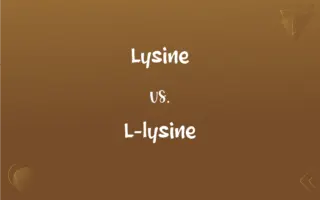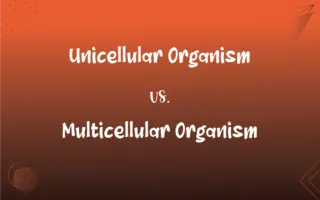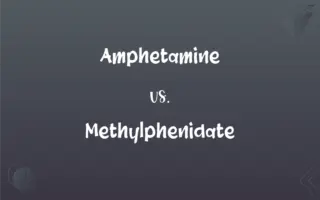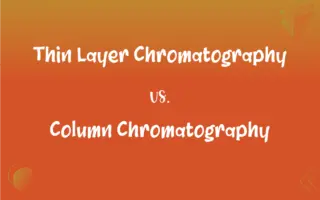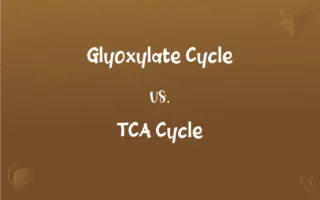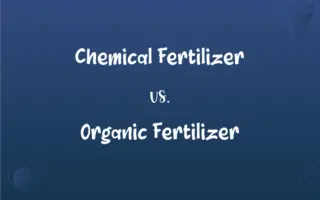Protoxylem vs. Metaxylem: What's the Difference?
Edited by Janet White || By Harlon Moss || Updated on October 28, 2023
Protoxylem is the first-formed xylem, functioning in water transport in young plant tissues; metaxylem develops later, with larger vessels for efficient water movement.

Key Differences
Protoxylem is the initial form of xylem, developing early in plant growth. Metaxylem matures after protoxylem, providing enhanced water transport.
In protoxylem, vessels are smaller and more primitive. Metaxylem vessels are larger and more specialized for effective water conduction.
Protoxylem often faces issues of collapsing under pressure. Metaxylem, with its robust structure, withstands pressure better.
Protoxylem serves young, growing parts of plants. Metaxylem takes over in mature plant regions, ensuring sustained water supply.
The presence of protoxylem marks early plant development stages. Metaxylem signifies a transition to more advanced growth phases.
ADVERTISEMENT
Comparison Chart
Developmental Timing
First-formed xylem, develops early.
Develops later, following protoxylem.
Vessel Size
Smaller vessels.
Larger vessels for efficient water movement.
Structural Integrity
Prone to collapsing under pressure.
More robust, withstands pressure better.
Functional Area
Serves young, growing plant parts.
Operates in mature plant regions.
Indication of Plant Growth
Marks early development stages.
Signifies advanced growth phases.
ADVERTISEMENT
Protoxylem and Metaxylem Definitions
Protoxylem
Protoxylem is the first-formed xylem in plants.
The protoxylem was evident in the young seedling.
Metaxylem
More robust, handles pressure well.
The metaxylem remained intact despite the high water demand.
Protoxylem
Indicates early plant growth stages.
The presence of protoxylem showed the plant was still young.
Metaxylem
Signifies advanced plant growth stages.
Metaxylem indicated the plant had entered a mature phase.
Protoxylem
It has smaller, less specialized vessels.
Protoxylem vessels in the sprout were quite narrow.
Metaxylem
Functions in mature plant parts.
Metaxylem provided ample water to the fully developed leaves.
Protoxylem
Protoxylem can collapse under pressure.
The plant’s protoxylem struggled under the increased water pressure.
Metaxylem
Metaxylem develops after protoxylem.
The metaxylem was forming as the plant matured.
Protoxylem
Serves young, developing tissues.
Protoxylem efficiently transported water in the growing leaves.
Metaxylem
It consists of larger, efficient vessels.
The plant's metaxylem had significantly wider vessels.
Protoxylem
The first xylem to form in a plant.
Metaxylem
(biology) The part of xylem, developing after protoxylem, that has larger cells and vessels.
FAQs
What is metaxylem?
Metaxylem is the xylem that develops after protoxylem, in more mature plants.
Where is metaxylem found?
Metaxylem is found in more mature regions of the plant.
What is protoxylem?
Protoxylem is the first type of xylem tissue that forms in young plants.
Where is protoxylem located?
Protoxylem is located in young, actively growing parts of a plant.
Is metaxylem more resistant to pressure than protoxylem?
Yes, metaxylem is structurally more robust and resistant to pressure.
Does protoxylem only exist in young plants?
Protoxylem is predominant in young plants but can exist in some parts of older plants.
Are protoxylem and metaxylem visible under a microscope?
Yes, both can be observed under a microscope, revealing structural differences.
Is protoxylem present in all plants?
Protoxylem is found in vascular plants, necessary for their early growth stages.
Are protoxylem vessels smaller than metaxylem vessels?
Yes, protoxylem vessels are generally smaller than those in metaxylem.
Is the transition from protoxylem to metaxylem gradual?
Yes, the transition typically occurs gradually as the plant grows.
Can metaxylem compensate for damaged protoxylem?
As plants mature, metaxylem can help compensate for some functions of damaged protoxylem.
What does metaxylem do?
Metaxylem efficiently conducts water and nutrients in mature plant parts.
What is the primary function of protoxylem?
Protoxylem mainly transports water in young plant tissues.
Why does protoxylem sometimes collapse?
Protoxylem may collapse due to its less robust structure and high internal pressure.
How do protoxylem and metaxylem affect plant health?
Both are essential for water and nutrient transport, crucial for plant health.
Does damage to protoxylem affect a young plant?
Damage to protoxylem can hinder water transport, affecting young plant growth.
Does the environment affect protoxylem and metaxylem development?
Environmental factors can influence the development and functionality of both protoxylem and metaxylem.
Can metaxylem replace protoxylem?
As plants mature, metaxylem gradually takes over the function of protoxylem.
Does metaxylem indicate a plant’s maturity?
The presence of metaxylem often indicates a more advanced stage of plant growth.
Can plants survive with only protoxylem?
Plants need both protoxylem and metaxylem for proper development and survival.
About Author
Written by
Harlon MossHarlon is a seasoned quality moderator and accomplished content writer for Difference Wiki. An alumnus of the prestigious University of California, he earned his degree in Computer Science. Leveraging his academic background, Harlon brings a meticulous and informed perspective to his work, ensuring content accuracy and excellence.
Edited by
Janet WhiteJanet White has been an esteemed writer and blogger for Difference Wiki. Holding a Master's degree in Science and Medical Journalism from the prestigious Boston University, she has consistently demonstrated her expertise and passion for her field. When she's not immersed in her work, Janet relishes her time exercising, delving into a good book, and cherishing moments with friends and family.






















